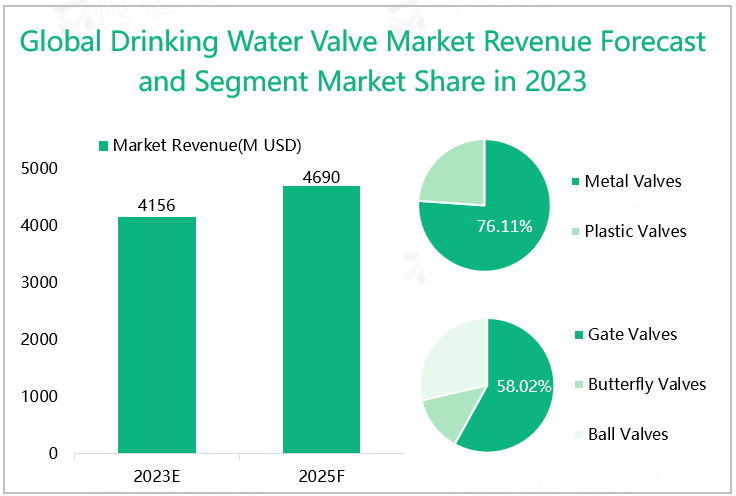A drinking water valve is a device used to control the water flow rate of the drinking water pipeline. It usually consists of a handle or valve stem that can be rotated or moved to open or close the water flow. In daily life, drinking water valves can help users control the flow and direction of water to meet their daily needs. In addition, drinking water valves can also play a crucial role in emergencies. For example, if a water pipe bursts or leaks, users can prevent water loss by closing the valve and taking appropriate measures to repair the pipeline as soon as possible.
According to different materials, drinking water valves can be divided into plastic valves and metal valves. According to our research data, the total revenue of the global drinking water valve market is expected to reach $4156 million in 2023, among which the estimated revenue of the metal valve market is $3163 million, with a market share of 76.11%; The estimated revenue from the plastic valve market is $993 million, with PVC, PP, and PE valve markets accounting for 20.54%, 18.23%, and 15.41%, respectively.
Based on different functions or purposes, drinking water valves can be divided into three types: gate valves, butterfly valves, and ball valves. Among them, gate valves are the most widely used. Data shows that the revenue share of gate valves in the global drinking water valve market is expected to reach 58.02% in 2023.
Global Drinking Water Valve Market Revenue Forecast and Segment Market Share in 2023
Source: www.globalmarketmonitor.com
Research shows that China is the largest revenue market for the global drinking water valve industry, with market revenue expected to reach $1132 million in 2023, accounting for 27.24%, followed by the European region, whose market revenue is estimated to reach $817 million, with a market share of 19.66%. In addition, Asian countries such as Japan and India also hold a relatively high share of the global market for drinking water valves. With the rapid economic development of economies such as China, Japan, and India, coupled with population growth, the government\'s efforts to provide clean and safe drinking water will promote the growth of the drinking water valve market. Although most valve companies in the Asia-Pacific region are still in the low-end market of the industry, their production capacity is still improving. Overall, the Asia-Pacific region holds an important position in the global drinking water valve market.
Forecast of Global Drinking Water Valve Market Revenue and Share by
Region/Country in 2023
|
Regions/Countries
|
Market Revenue(M USD)
|
Market Share
|
|
North America
|
648
|
15.59%
|
|
Europe
|
817
|
19.66%
|
|
China
|
1132
|
27.24%
|
|
Japan
|
196
|
4.72%
|
|
India
|
723
|
17.40%
|
|
Southeast Asia
|
377
|
9.07%
|
Source:
www.globalmarketmonitor.com
In the future, with the economic development and
population increase of emerging countries, coupled with the further development
of water infrastructure construction, the frequency of using drinking water
valves will also increase. At the same time, as governments around the world
attach importance to the construction of drinking water projects in remote
areas, drinking water facilities are also constantly improving. As an important
component of the construction of drinking water facilities, the utilization
rate of drinking water valves is expected to increase greatly.
For more information, please click: 《Valve Market - Global Professional Analysis and Forecast to 2026》.
